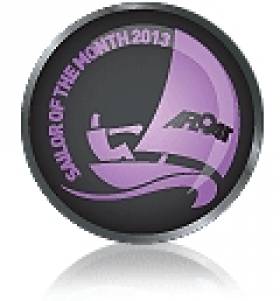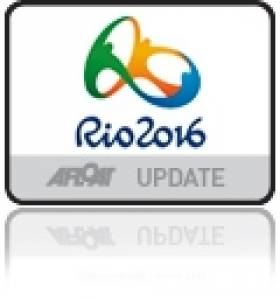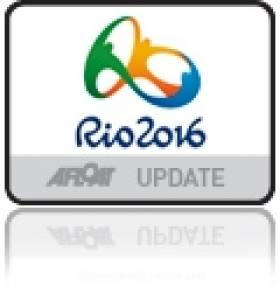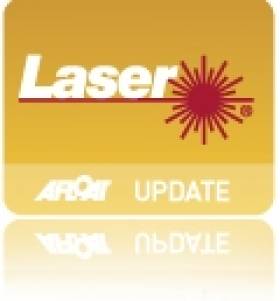Displaying items by tag: Finn Lynch
Finn Lynch, Olympic Laser Sailing Campaigner for Rio 2016
When Finn Lynch won the Silver at 2012's ISAF Youth Worlds in Dublin Bay, it was the maturity of the 16-year-old's approach which drew the most favourable comment. The following September, at the ripe old age of 17, he was even more emphatically Irish sailing's Captain Cool. He took Gold in the U21 division, Silver in the Europeans, and Bronze in the Worlds. A phenomenal achievement, that won him a worthy September Sailor of the Month award from Afloat but it was only the start of things to come for the talented single–hander.
Lynch of County Carlow also counts the National Yacht Club as his home club, even if he did start his sailing at the lakeside club of Blessington up in the Wicklow hills. Early influences of his elder Ben plus a driving passion for youth sucess has propelled the youngster onto the Olympic campaign trial for Rio even when he could still be sailing at youth level, foregoing a place at 2014's ISAF youth worlds.
The Carlow teen is now a step closer to fulfilling his dream of representing Ireland in Rio 2016after earning a second Laser Standard nation place at Spit Olympic week in Croatia in April 2014. Lynch's tenth overall result puts two Irish Lasers on the startline at the Olympic qualifier in Santander, Spain this autumn. The National Yacht Club sailor finished 10th overall and tenth country in Crotia today and joins London 2012's James Espey with the aim of qualifying Ireland for Rio at the first opportunity this September.
#laser – Just days after success in Croatia on the European circuit, Laser sharp Finn Lynch was back in action in home waters to take Laser Munster Championships honours at the brand new Baltimore Sailing Club.
Over 100 sailors were competing for the Easter weekend Danske Bank sponsored event in three Laser classes; 4.7, radial and standard rigs.
Day one saw 10-12 knots of breeze in glorious sunshine. In the first race in the Olympic Laser Standard class Rory Lynch was in first place but it was his brother Finn who was the overall winner with a 5, 2, 1 result in the three races of the day. On Day 2 Finn from the National Yacht Club continued his form with a 4, 1, 1, in the second day to claim victory over Robbie Gilmore from Strangford Lough and in third place Eoin Keller from Lough Derg Yacht Club and Fionn Lyden from Baltimore in fourth place.
17–year–old Lynch came to Baltimore following a strong performance at the Split Olympic week where he finished tenth overall but much more importantly earned a place on the Irish Olympic sailing team and a second Laser spot for Ireland at the Olympic qualifier in Santander, Spain in September. Lynch will join London 2012's James Espey (currently lying 70th from 128 starters after day one at the ISAF world cup in Hyeres) to fight for Ireland's single space on the Rio startline.
In the 37 strong Radial class, after day one Ryan Glynn from Ballyholme YC was ahead of Daragh O'Shea, Kinsale YC, Jack Higgins, Royal St George Yacht Club and local sailor Mark Hassett and Erica Ruigrok from Rush SC. Day Two saw stronger steadier breezes and the day started with Erica Ruigrok winning the first race with Mark Bolger from Royal St George/Baltimore SC winning the second race from strong local competition from Dermot Lyden and Mark Hassett. The final race was won by Ryan Glynn who was the overall winner by an impressive margin of 23 points with Mark Hassett in second place, Erica Ruigrok from Rush SC in third and Mark Bolger finishing fourth.
In the 4.7 class Johnny Durcan from RCYC who was the overnight leader went on to win the event with Rory Caslin from the National YC and Daniel Raymond also from the National YC in Dun Laoghaire finishing in second and third respectively.
#olympicsailing–17–year–old Finn Lynch is a step closer to fulfilling his dream of representing Ireland in Rio 2016 tonight after earning a second Laser Standard nation place at Spit Olympic week in Croatia. Lynch's tenth overall result puts two Irish Lasers on the startline at the Olympic qualifier in Santander, Spain this autumn.
The National Yacht Club sailor, who earned world youth silver in 2012, finished 10th overall and tenth country in Crotia today and joins London 2012's James Espey with the aim of qualifying Ireland for Rio at the first opportunity this September.
The Carlow teen showed the depth of his ambition again last season when he took Laser European honours on his home waters of Dublin Bay winning bronze in the Men's Radial Worlds, silver in the Europeans and gold in the U21 category. The 17-year-old from Bennekerry County Carlow sailed consistently throughout that 12 race regatta with nine top-five finishes, including two race wins.
The Carlow Laser racer was our sailor of the month for July last year and it looks like there's no stopping the youngster's progress.
Strangford's Chris Russell was also competing in Split this week. Regatta results downloadable below.
Laser Youth Finn Lynch is Sailor of the Month for September
#sailorofthemonth – The adjudicators in the Afloat.ie "Sailor of the Month" award for September have been in the happy position of having a proliferation of major achievements to choose from, and they have the bonus of being able to draw on the "Previous Award" clause.
Like everyone else, we agree that Annalise Murphy's comprehensive sweeping of the board at the Laser Europeans & Worlds at her home club of the National in Dun Laoghaire was in a league of its own. But we've already been on the case with the Murphy performance this year, as she was SoM in May after taking two gold medals in major European regattas.
So when the award for Sailor of the Year 2013 is up for consideration, that May success will be rated as a double win. But thanks to this bit of prestidigitation, we still have September's gong to give out, and that goes to young Finn Lynch of County Carlow. He also counts the National YC as his home club, even if he did start his sailing at the lakeside club of Blessington up in the Wicklow hills.
When Lynch won the Silver at last year's ISAF Youth Worlds in Dublin Bay, it was the maturity of the 16-year-old's approach which drew the most favourable comment. And this September, at the ripe old age of 17, he was even more emphatically Irish sailing's Captain Cool. He took Gold in the U21 division, Silver in the Europeans, and Bronze in the Worlds. A phenomenal achievement, and a worthy September Sailor of the Month.
Finn Lynch Medals In Dun Laoghaire
#LaserEuro2013 - Finn Lynch has taken bronze in the Men's Radial Worlds, silver in the Europeans and gold in the U21 category at the Laser European and World Championships in Dun Laoghaire.
It's a second medal for hosts the National Yacht Club, who have been staging the 324-boat championship all this week. Minutes earlier this afternoon Annalise Murphy sailed to a European title in the women's Laser Radial division.
As for Lynch, only this morning The Irish Times was favouring his chances in the gold fleet after fellow Irish sailor Fionn Lyden slipped down the leaderboard.
The 17-year-old from Bennekerry, Co Carlow sailed consistently throughout the 12 regatta races with nine top-five finishes, including two race wins.
The Carlow Laser racer was our sailor of the month for July last year and it looks like there's no stopping the youngster's progress.
#LaserEuros2013 – Annalise Murphy goes into the final races of the Laser European and World Championships tomorrow on her native Dublin Bay with a comprehensive 17 point lead ahead of Holland's Olympic silver medallist Marit Bowmeester.
With the prospect of a breezy finale on the waters off Dun Laoghaire Murphy is looking to resume the same kind of form which has led to seven wins from her nine starts here and convert her big lead to her first major Laser Radial title. A disappointing 27th in today's light breezes is her discardable result.
In contrast the contest for the titles and trophies in the Olympic men's fleet is very delicately poised after two tricky races in light and unpredictable northerly winds today which made consistency very elusive. Indeed of the top ten sailors in the Men's fleet all sailed one good result and one poor, discarded race.
As Britain's Nick Thompson promoted himself to the top of the standings with a second place in the second of their pair of races today to earn a two points margin ahead of Croatia's Tonci Stipanovic and three up on Holland's Rutger Schaardenburg, Brazil's Robert Scheidt returned to shore frustrated to have scored his second poor result in consecutive days. After winning the first race he fell into a wind hole in the second contest and struggled to a 24th.
Scheidt, who will bid for his ninth Laser world title in Oman in November, has returned to the class after seven years in the Star keelboat. He believes that racing in amongst most of the best in the class at the moment he is close to being back to his best, but needs to polish up on his consistency.
"I think that independent of tomorrow's results I have the chance to win regattas the way that I am sailing." Scheidt confirmed today, "I think that I have already proven this week that I sail well in strong winds, I can sail well in light winds. I am still not as consistent as I used to be but it shows the field is pretty open and I can still do well."
After taking time out from the Laser Thompson, who missed out on the British Sailing Team's selection to the last Olympics despite twice finishing runner up at consecutive World Championships behind Australia's Tom Slingsby, would love to mark his return with the first major title of his long and distinguished career. Since winning the 2004 ISAF Youth World title in 2004, Thompson has won world cup and international regattas but has yet to win a major class title.
"I am pleased with the way I have sailed at the event so far" Thompson said, "I have made few mistakes. The Worlds is the main focus but this event is hugely important, but for me it is nice to feel I am sailing back on top of my game again. The competition is great with Rutger, Scheidt and Tonci all up there and so I am looking to an interesting final day."
Thompson's pair of results – a 30th and a second – were characteristic of the day's highly unpredictable conditions. In the offshore northerly breeze, choosing the best side of the first beat was key but there were big holes in the breeze which summarily halted many of the top seeds in their tracks.
Croatia's Tonci Stipanovic, twice European champion in the past, has a slightly better discard in his locker, but Thompson has been better in the stronger breeze, scoring best of the fleet in Wednesday's wilder winds.
Although the men finished two races for the Olympic rigged fleets, the corresponding Women's Radial class only managed one because the fickle breeze died away too much. Murphy was disappointed not to have the chance to atone immediately for her disappointing 27th place, while Bouwmeester was also dismayed that only one race in her preferred lighter conditions was sailed.
The Dutch sailor said "It is a shame to only get one race. It looked like a bit of an early decision. That is a shame. It was a tricky race which reminded me a bit of Weymouth in the N'ly wind, so it was nice to race in that again. I was just in the top group at the windward mark and then got up to second on the second upwind. But we will be back hiking again tomorrow."
Annalise Murphy says she will change nothing for the decisive final day, concentrating on making better starts than today's which was the start of a frustrating downwards spiral which was concluded when she ran out of breeze close to the finish line. "It was difficult" Murphy said, " I had a bad start and struggled to get into the race in the first half, but made a good comeback on the second upwind, the last downwind and the reach to get into the top 15. But I was close to the finish line and then the wind died. I was not moving and could do nothing at all about it. I lost 15 places at the finish line and so that was disappointing. It was a shame not to get a second race in. The breeze came in but it is always hard to tell."
"I am disappointed with today. I would much preferred to have a 15th rather than a 27th or whatever it is. I will just have to get out there and have good races on the last day. I just need to get better starts than today's and try and not make any mistakes."
While Bouwmeester rose to second overall she is now just three points up on Britain's Ali Young.
In the Men's Laser Radial World Championship Australia's defending champion Tristan Brown won again to build his lead to 18 points. Ireland's Finn Lynch, the home club's ISAF Youth World Championships silver medallist leads the European Championship by two points ahead of Poland's three times world champion Marcin Rudawski. Lynch, who has climbed the rankings all week, is set for a place on the podium if her can maintain his current form in the final rounds.
Lynch, who sails from the National YC said "The conditions were very shifty and challenging conditions today. I had a good start and was in 10th at the first mark and then climbed to first but then dropped to third at the line. Tomorrow I am hoping for two solid races and to hold on to a podium position tomorrow."
Top three by class
Laser Radial Women's European Championship
1. Annalise Murphy, IRL, 9 points
2. Marit Bouwmeester, NED, 26
3. Alison Young, GBR, 29
Laser Radial Men's World Championship
1. Tristan Brown, AUS, 12
2. Finn Lynch, IRL, 30
3. Marcin Rudawski, POL, 32
Laser Standard Men's European Championship
1. Nick Thompson, GBR, 29
2. Tonci Stipanovic, CRO, 31
3. Rutger Schaardenburg, NED, 32
http://www.lasereuropeans2013.com/ for full results.
Amazing Annalise Murphy Counts Five Race Wins to Lead Laser European Championships
#lasereuros2013 – Annalise Murphy wins two more races today to lead the Laser Europeans in Dun Laoghaire by seven points. In bright sunshine, warm temperatures and even an unusual sea breeze, favourite Annalise Murphy remains the only sailor at the Laser European & World Championships to complete the six-race Qualifying Series counting a score line of five race wins.
The satisifed Dun Laoghaire sailor tweeted after racing: 'Wins in both races today @LaserEuros2013 ! I am going to sleep well tonight! #sotired'
The change from the offshore, shifty westerly breezes of the first two days might have been welcomed, but in their place was a difficult, at times frustrating, thermal sea breeze which was often riddled with holes and peppered with puffs which still brought significant changes in wind direction. But the change did not seem to worry Murphy who built a significant lead in both of her races for another two winning guns. But as the Final Series now starts - the business end of the championships - she will face much stiffer competition.
"I'm feeling pretty good. Now it's gold fleet and it will be very different, much harder with twice as many good people in the fleet. I feel good after these last few days but there are three days to go. I am taking nothing for granted. I am just looking to keep sailing well, to get good starts and hopefully it will work out. I don't worry about what the weather forecast might bring, they have been wrong the last three days and so there is no point in speculating" Murphy, who is sailing on her home waters, reported.
She goes forward with a lead of seven points over Belgium's Evi Van Acker, the 2012 Olympic bronze medallist who finished second twice today, whilst the British Sailing Team's Ali Young and Denmark's Sarah Gunni are three points further back on 17 points.
Fionn Lyden drops to second
In the Laser Radial Men's fleet Baltimore's Fionn Lyden dropped to second after a 20th in the second race today but remains only one point behind Australian leader Tristan Brown. "I got everything wrong" Lyden said later, "I had a reasonable start and thought the wind was going to shift left but it didn't. I was in the bottom 15 at the first mark but gained about 15 places on the run. I thought it was going to shift left again on the second beat but it didn't. I then gained a few more places on the reach but finished 20th. It was a weird race".
Last year's European Championships runner-up, Sweden's Jesper Stalheim, goes into the Final Series of the Men's Olympic class with a lead of two points over Brazil's Robert Scheidt who he kept behind him twice today as he sailed to a first and a second, with the five times Olympic medallist taking second and third.
Scheidt confirmed again today that he is racing the Laser not through any sense of obligation but because he loves it, and it is his best option at the moment for him to win a sixth medal. "I think this is my only option in terms of an Olympic class. It is a boat I know, I have the experience, easy to start a campaign. The most important thing is I still enjoy sailing the boat. I would not be doing this if I did not enjoy sailing this boat" he smiled in the Dun Laoghaire sunshine this afternoon.
Of his races today he reported "In the first race I rounded the top mark in 25th and so I was pleased to come back from that. It was pretty difficult with a lot of holes in the breeze. It was very fluky wind, getting up to 16 - 17 knots but then dropping very quickly to four knots. That made the racing very difficult. Also downwind sometimes you were going but sometimes you were stopped. I am happy to have made two results in the top three today. But tomorrow it is like the start of a new regatta. We all start again in the one fleet".
Although Swede Jesper Stalheim sailed to first and second place finishes, he maintained he had found the conditions confounding at times. "It was a game of luck at times and my luck again seemed to work out" said Stalheim, "There were such big pressure differences. You would go from full hiking to no wind in a matter of seconds and just stop. And people would still be going around you. It feels really good to be sailing well though".
"The conditions were weird at the last Europeans where I was second. I must be OK at it. But the standard there was not so high (as many sailors were in Weymouth preparing for the Olympics). I feel I am sailing well. I will have to be good from here."
Stipanovic shares the same raw motivation as Annalise
With a first and a third today Croatia's Tonci Stipanovic is up to third overall. Twice Laser European Champion – in 2010 and 2011 – Stipanovic shares the same raw motivation as Annalise Murphy. He too missed out painfully on an Olympic medal in the Medal Race at Weymouth and Portland just over a year ago.
"It will be difficult as of now. You have to sail well on the first day of the finals, the pressure really is on then. If you don't it becomes complicated. It is not necessary to win races, just get good results" said Stipanovic.
See here for full results
Lynch Wins Radial Title at Royal Cork Laser National Championships
#laser – Finn Lynch proved his ISAF silver medal status again at the weekend fighting off a significant internatiional challenge for the Irish Laser Radial title at Royal Cork Yacht Club. The National Yacht Club's Lynch counted only one result outside the top ten in the 79–boat fleet ending up seven points clear at the top of his 79–boat fleet, the only Irish boat in the top five. Results downloadable below as a jpeg file. Second was Australian Tristan Brown. Britain's Jon Emett from Weir Wood Sailing Club was third. Lynch's victory comes after a summer of international competition including the Under 21 World Championships in Hungary.
Olympic campaigner Annalise Murphy, who has just returned from a three week training stint at the Olympic venue in Rio de Janerio, finished seventh overall and tweeted afterwards: "finished nationals @royalcork, good practice for euros next week! I hope to do a better job then I did this weekend!
The Vodafone sponsored Irish event at Royal Cork with a total entry of 160–boats had the added spice of international competition due to the fact it is a forerunner to this weekend's Laser European Championships on Dublin Bay.
In the Standard rig, Chirs Penney from East Antrim Boat Club took the overall win. Rush Sailing Club's Alan Ruigrok was second. Russian entry Maxim Nikolaev was third in the 36–boat fleet.Results downloadable below as a jpeg file.

East Antrim's Chris Penney won the Standard Division. Chris's father Stephen, in 11th place, won the Masters division. Photo: Bob Bateman
In the Laser 4.7 rig, Daniel Raymond of the National Yacht Club was the overall winner from club mate Nicole Hemeryck. 38 competed. Results downloadable below as a jpeg file.
#laser – Ireland's World Youth Silver medallist Finn Lynch has finished 13th overall in the 50-boat Laser Standard Men's U19 World & European Championship 2013, another step in towards an Olympic campaign for the talented youth sailor. In the U21 category, the National Yacht Club sailor was 52nd. Irish team mate Fionn Lyden of Schull was 35th and Philip Doran, 59th in the seven race, one discard series on Lake Balaton, Hungary. Full results available to download below.
Meanwhile, in other Irish Laser sailing news, Chris Penney, Seafra Guilfoyle & Cliodhna O'Regan Took the Lough Ree Connaught Laser Titles last weekend at the same time as some of the world's top Laser sailors called to Belfast shores to pay James Espey's home waters a visit. It bodes well for the Laser Europeans in Dun Laoghaire later next month.
#laser – Last year's ISAF Youth Silver medallist Finn Lynch opened his Laser Standard Men's U21 World & European Championship 2013 account on Lake Balaton, Hungary with a fifth place yesterday and is lying 27th overall after three qualifying races. Download results below. As we reported earlier, the Blessington Sailing Club sailor is in Hungary with Wexford's Philip Doran and Fionn Lyden from Schull. Doran is currently 39th and Lyden is 70th.




































































